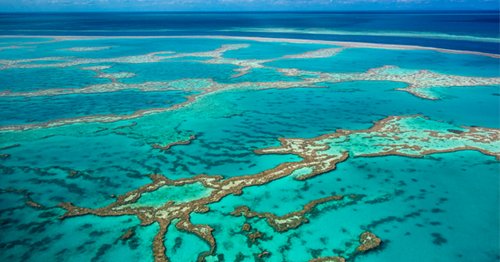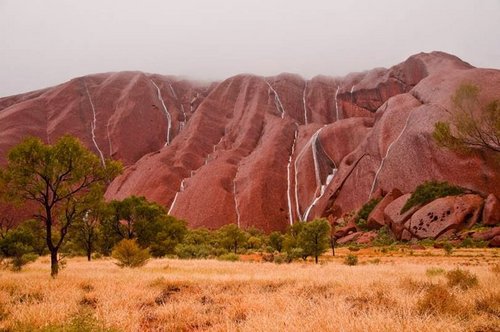Australia Top 10 – part two
Part one of my top 10 Australian ‘wish list’ sites was in or near Sydney, Australia’s largest city, but this continent has so much to offer. Let’s venture out to see more!
Great Barrier Reef
The Great Barrier Reef off of the coast of Australia is the largest reef formation in the world. It is made from almost 3,000 individual coral reefs and extends for over 1,600 miles. It’s so large, in fact, that it can be seen from space. Since that’s true, I’m hoping I will be able to see it from the airplane!
Besides being gigantic and jaw-droppingly beautiful, the Great Barrier Reef is home to an amazing diversity of animal life. Over 1,800 types of fish, 125 types of sharks, 350 different types of coral and many other life forms all call the Reef their home!
 The Great Barrier Reef is such a lively place! Photo credit: Pre-tend E-magazine
The Great Barrier Reef is such a lively place! Photo credit: Pre-tend E-magazine
 These walls of reef look like a maze! Think you could swim your way through? Photo credit: Huffington Post
These walls of reef look like a maze! Think you could swim your way through? Photo credit: Huffington Post
Cable Beach
While it may be surprising to think of riding camels along a sunny beach in Australia, at Cable Beach it is encouraged! Cable Beach is located near Broome, a relatively small tourist town on the northwestern coast of the continent. At this beach, visitors can ride camels along the water’s edge and through rocky mountain trails. This sounds fantastic to me! Hope we’ll have time to do this!
 The camel riding tours along Cable Beach in the Northwest of Australia. Photo credit: Travel Places
The camel riding tours along Cable Beach in the Northwest of Australia. Photo credit: Travel Places
Ayers Rock
While I may not have time to see Uluru, or Ayers Rock, it’s definitely on my wish list. Arguably the most famous image of Australia’s outback region, Ayers Rock is a huge sandstone deposit and one of the main attractions in Uluṟu-Kata Tjuṯa National Park. It’s considered sacred to the Australian Aborigines, the native people of the continent.
Something I find interesting about Ayers Rock is what it looks like when it rains. Some people think the rock appears to cry. As the rain fills the upper crevices of the rock it washes along channels carved by erosion and falls off of the sides of the rock. Who knew rocks could cry? What do you think? Take a look at the picture below.
 What beautiful sunset behind Ayers! Photo credit: John Coppi, CSIRO
What beautiful sunset behind Ayers! Photo credit: John Coppi, CSIRO
 The water from the rains flows down the sides of Uluru. Photo credit: Tom McShane
The water from the rains flows down the sides of Uluru. Photo credit: Tom McShane
Kakadu National Park
You can't see Australia without making a point of seeing the countryside's crocodiles. And from what I’m told, Kakadu Park is not only a great place to see crocs and other wildlife, it also boasts one of the best places in Australia to get the true Australian experience - all in one place. The park is absolutely huge, covering nearly 20,000 square kilometers in the north-central part of the continent. To put that in perspective, geographically speaking that’s about the size of these U. S. states:
- New Jersey – 22,600 square kilometers
- New Hampshire - 24,200 square kilometers
- Vermont – 24,900 square kilometers
WOW! That is big!
Here’s something interesting: Kakadu National Park has the world's only giant cement crocodile. Confused? I was too until I saw the picture of this hotel. It’s a giant building shaped like one of the park's star attractions.
 I’ll be sure to say ‘After while, crocodile,’ when I leave Kakadu! That is, if I get to go. Photo credit: Parks Australia
I’ll be sure to say ‘After while, crocodile,’ when I leave Kakadu! That is, if I get to go. Photo credit: Parks Australia
Healsville Sanctuary
Do you want to know where one of the best places to see and safely interact with native Australian wildlife is? It’s the Healsville Sanctuary, in Victoria, Australia. While you may think this would be similar to the Taronga Zoo, from what I’m told the Healsville Sanctuary offers one thing that traditional zoos do not – the opportunity to get up close and personal with unique Australian animals in a stunning bushland setting. Wouldn’t it be exciting to pet the fur of a kangaroo, pose for a picture with a koala, get a kiss on the cheek from a dingo or look eye to eye with an emu? Sure hope I can fit this in!
 Feeding a Kangaroo! Photo credit: Zoos Victoria
Feeding a Kangaroo! Photo credit: Zoos Victoria
 Healsville Sanctuary logo. Photo credit: Zoos Victoria
Healsville Sanctuary logo. Photo credit: Zoos Victoria
Tasmania
You’ve heard of the cartoon character called the Tasmanian devil, right? Well, the real Tasmanian devils aren't swirling tornado monsters; they are meat-eating marsupials about the size of a small dog and native to Tasmania, the largest of Australia's satellite states.
 Check out the Tasmanian devil at the Healesville Sanctuary. Photo Credit: Amie Hindson, Zoos Victoria
Check out the Tasmanian devil at the Healesville Sanctuary. Photo Credit: Amie Hindson, Zoos Victoria
Tasmania is an island that shares many geological features with Australia's neighbor New Zealand, and comes in between our journey's starting point in Australia and destination at McMurdo. Tasmania looks like a lost ancient world, doesn't it? I wonder what kind of ancient life lived here long ago?
 A map of Tasmania. Photo credit: Touring Tasmania
A map of Tasmania. Photo credit: Touring Tasmania
 This looks like a mystical grove. Photo credit: Tasmanian Tour Company
This looks like a mystical grove. Photo credit: Tasmanian Tour Company
